Basal Cell Carcinoma
Introduction:
This page has important information about skin cancer.* Skin cancer is the most common type of cancer in this country. About one million Americans develop skin cancer each year.
You will read about causes and ways to prevent skin cancer. You will find information about symptoms, diagnosis, and treatment. You will also learn how to do a skin self-exam.
Scientists are studying skin cancer to find out more about how it develops. And they are looking for better ways to prevent and treat it.
The Skin
The skin is the body's largest organ. It protects against heat, light, injury, and infection. It helps control body temperature. It stores water and fat. The skin also makes vitamin D.
The skin has two main layers:
- Epidermis: The epidermis is the top layer of the skin. It is mostly made of flat cells. These are squamous cells. Under the squamous cells in the deepest part of the epidermis are round cells called basal cells. Cells called melanocytes make the pigment (color) found in skin and are located in the lower part of the epidermis.
- Dermis: The dermis is under the epidermis. It contains blood vessels, lymph vessels, and glands. Some of these glands make sweat, which helps cool the body. Other glands make sebum. Sebum is an oily substance that helps keep the skin from drying out. Sweat and sebum reach the surface of the skin through tiny openings called pores.
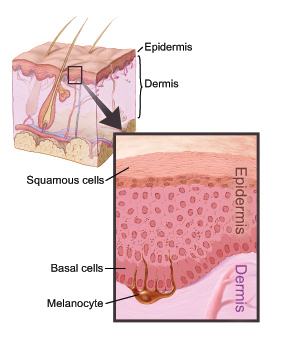 This picture shows the layers of the skin.
This picture shows the layers of the skin.
Understanding Skin Cancer
Skin cancer begins in cells, the building blocks that make up the skin. Normally, skin cells grow and divide to form new cells. Every day skin cells grow old and die, and new cells take their place.
Sometimes, this orderly process goes wrong. New cells form when the skin does not need them, and old cells do not die when they should. These extra cells can form a mass of tissue called a growth or tumor.
Growths or tumors can be benign or malignant:- Benign growths are not cancer:
- Benign growths are rarely life-threatening.
- Generally, benign growths can be removed. They usually do not grow back.
- Cells from benign growths do not invade the tissues around them.
- Cells from benign growths do not spread to other parts of the body.
- Malignant growths are cancer:
- Malignant growths are generally more serious than benign growths. They may be life-threatening. However, the two most common types of skin cancer cause only about one out of every thousand deaths from cancer.
- Malignant growths often can be removed. But sometimes they grow back.
- Cells from malignant growths can invade and damage nearby tissues and organs.
- Cells from some malignant growths can spread to other parts of the body. The spread of cancer is called metastasis.
Types of Skin Cancer
Skin cancers are named for the type of cells that become cancerous. The two most common types of skin cancer are basal cell cancer and squamous cell cancer. These cancers usually form on the head, face, neck, hands, and arms. These areas are exposed to the sun. But skin cancer can occur anywhere.
- Basal cell skin cancer grows slowly. It usually occurs on areas of the skin that have been in the sun. It is most common on the face. Basal cell cancer rarely spreads to other parts of the body.
- Squamous cell skin cancer also occurs on parts of the skin that have been in the sun. But it also may be in places that are not in the sun. Squamous cell cancer sometimes spreads to lymph nodes and organs inside the body.
If skin cancer spreads from its original place to another part of the body, the new growth has the same kind of abnormal cells and the same name as the primary growth. It is still called skin cancer.
Risk Factors
Doctors cannot explain why one person develops skin cancer and another does not. However, we do know that skin cancer is not contagious. You cannot "catch" it from another person.
Research has shown that people with certain risk factors are more likely than others to develop skin cancer. A risk factor is something that may increase the chance of developing a disease.
Studies have found the following risk factors for skin cancer:- Ultraviolet (UV) radiation: UV radiation comes from the sun, sunlamps, tanning beds, or tanning booths. A person's risk of skin cancer is related to lifetime exposure to UV radiation. Most skin cancer appears after age 50, but the sun damages the skin from an early age.
UV radiation affects everyone. But people who have fair skin that freckles or burns easily are at greater risk. These people often also have red or blond hair and light-colored eyes. But even people who tan can get skin cancer.
People who live in areas that get high levels of UV radiation have a higher risk of skin cancer. In the United States, areas in the south (such as Texas and Florida) get more UV radiation than areas in the north (such as Minnesota). Also, people who live in the mountains get high levels of UV radiation.
UV radiation is present even in cold weather or on a cloudy day.
- Scars or burns on the skin
- Infection with certain human papillomaviruses
- Exposure to arsenic at work
- Chronic skin inflammation or skin ulcers
- Diseases that make the skin sensitive to the sun, such as xeroderma pigmentosum, albinism, and basal cell nevus syndrome
- Radiation therapy
- Medical conditions or drugs that suppress the immune system
- Personal history of one or more skin cancers
- Family history of skin cancer
- Actinic keratosis: Actinic keratosis is a type of flat, scaly growth on the skin. It is most often found on areas exposed to the sun, especially the face and the backs of the hands. The growths may appear as rough red or brown patches on the skin. They may also appear as cracking or peeling of the lower lip that does not heal. Without treatment, a small number of these scaly growths may turn into squamous cell cancer.
- Bowen's disease: Bowen's disease is a type of scaly or thickened patch on the skin. It may turn into squamous cell skin cancer.
If you think you may be at risk for skin cancer, you should discuss this concern with your doctor. Your doctor may be able to suggest ways to reduce your risk and can plan a schedule for checkups.
Prevention
The best way to prevent skin cancer is to protect yourself from the sun. Also, protect children from an early age. Doctors suggest that people of all ages limit their time in the sun and avoid other sources of UV radiation:
- It is best to stay out of the midday sun (from mid-morning to late afternoon) whenever you can. You also should protect yourself from UV radiation reflected by sand, water, snow, and ice. UV radiation can go through light clothing, windshields, windows, and clouds.
- Wear long sleeves and long pants of tightly woven fabrics, a hat with a wide brim, and sunglasses that absorb UV.
- Use sunscreen lotions. Sunscreen may help prevent skin cancer, especially broad-spectrum sunscreen (to filter UVB and UVA rays) with a sun protection factor (SPF) of at least 15. But you still need to avoid the sun and wear clothing to protect your skin.
- Stay away from sunlamps and tanning booths
Symptoms
Most basal cell and squamous cell skin cancers can be cured if found and treated early.
A change on the skin is the most common sign of skin cancer. This may be a new growth, a sore that doesn't heal, or a change in an old growth. Not all skin cancers look the same. Skin changes to watch for:
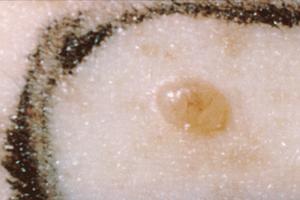
- Small, smooth, shiny, pale, or waxy lump
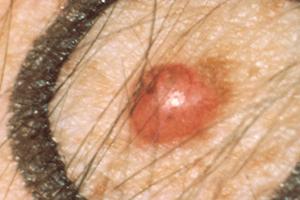
- Firm, red lump
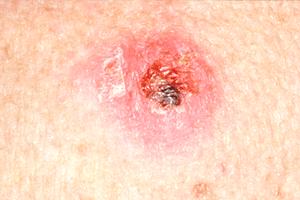
- Sore or lump that bleeds or develops a crust or a scab
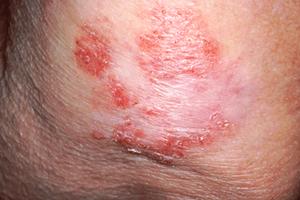
- Flat red spot that is rough, dry, or scaly and may become itchy or tender
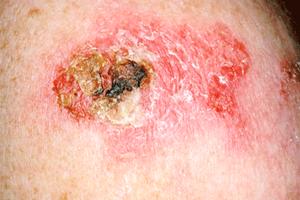
- Red or brown patch that is rough and scaly
Sometimes skin cancer is painful, but usually it is not.
Checking your skin for new growths or other changes is a good idea. A guide for checking your skin is below. Keep in mind that changes are not a sure sign of skin cancer. Still, you should report any changes to your health care provider right away. You may need to see a dermatologist, a doctor who has special training in the diagnosis and treatment of skin problems.





































